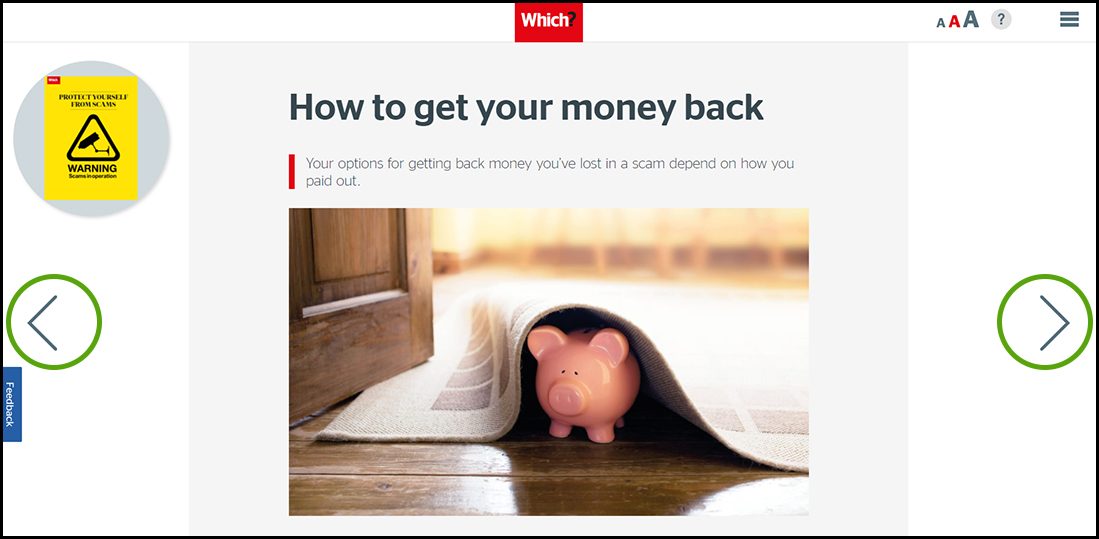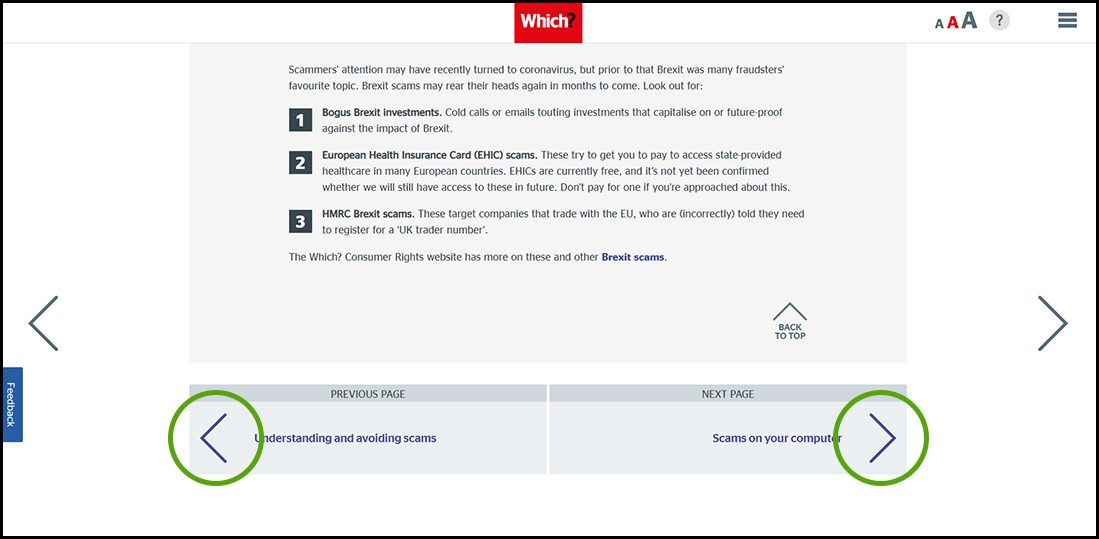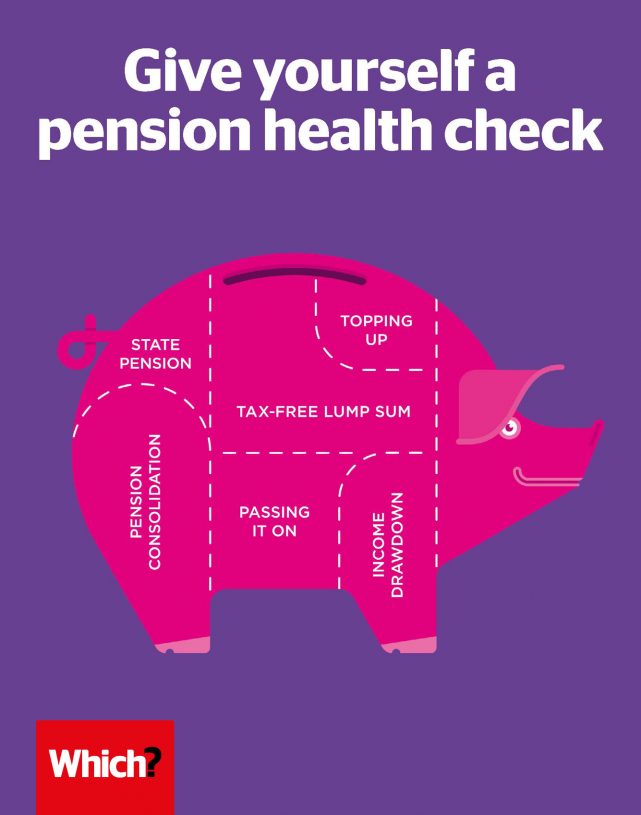User guide
Finding your way around the guide
To navigate between pages, click or tap the arrows to go forwards to the next page or backwards to the previous one. The arrows can be found either side of the page and at the bottom, too (circled in green, below).


Menu/table of contents
Click or tap on the three horizontal lines in the top-right of your screen to open the main menu/table of contents. This icon is always visible whether you're using a computer, tablet or smartphone. The menu will open on top of the page you’re on. Click on any section title to visit that section. Click the cross at any time to close the table of contents.
Text size
On a computer, you'll see three different sized letter 'A's in the top-right of your screen. On a smartphone or tablet these are visible when you open the menu (see above). If you’re having trouble reading the guide, click or tap on each of the different 'A's to change the size of the text to suit you.
Pictures
On some images you'll see a blue double-ended arrow icon. Clicking or tapping on this will expand the picture so you can see more detail. Click or tap on the blue cross to close the expanded image.
Where we think a group of images will be most useful to you, we've grouped them together in an image gallery. Simply use the blue left and right arrows to scroll through the carousel of pictures.
Links
If you see a word or phrase that's bold and dark blue, you can click or tap on it to find out more. The relevant website will open in a new tab.
Jargon
If you see a word or phrase underlined, click or tap on the word and small window will pop up with a short explanation. Close this pop-up by clicking or tapping the cross in the corner.
Help
On a computer, you'll see a question mark icon in the top-right of your screen. On a smartphone or tablet this is visible when you open the menu (see above).
Clicking or tapping on the question mark will open this user guide. It opens on top of the page you're on and you can close it any time by clicking or tapping the cross in the top-right corner.

Getting the best deal from annuities
While pension freedom has given people more choice about how to use their retirement savings, buying an annuity will still be the best option for many.
Although the pension freedom reforms introduced in April 2015 were, in part, a response to concern about low annuity rates, an annuity will still be the right option for large numbers of people, as they convert savings into income.
Q: Is an annuity right for me?
A: An annuity is an insurance product that allows you to swap your pension savings on retirement for a guaranteed regular income for the rest of your life. The amount you get is determined by the rate the annuity provider offers at the time you cash in your savings.
It’s possible that you'd be able to generate more income from a different option, such as income drawdown, but the advantage offered by an annuity is its guarantee – you know exactly what you stand to receive for the rest of your life, rather than having to worry about factors such as the fluctuating value of your investments or whether your savings might be running out.
Q: Where do I get an annuity from?
A: Three months or so before you retire, your pension provider will send you details of the annuities it offers, the value of your pension savings and how much income it’s prepared to offer you. Remember that you don’t have to buy an annuity from your pension provider – you’re entitled to take the open-market option and shop around for a better deal elsewhere.
In fact, you really should do this. Savers can boost their pension income by as much as 30% by looking for a better deal. This is so important that pension providers are now legally bound to check that you have considered all the options. However, for a small minority of people, buying elsewhere may not be the best option. If your plan involves a guaranteed annuity rate (GAR), find out what it is – these can be as high as 10%, which is higher than any rate you could find on the open market.
Q: How are annuity rates calculated?
A: Annuity rates reflect your life expectancy, health and lifestyle – the longer you live, the more payments you’ll receive from an annuity. So, the greater your life expectancy, the lower the annuity rate you can expect to be offered. Likewise, if you’re expected to live for a shorter time, you may get a better annuity rate. Annuities are also affected by interest rates and inflation. This is because pensions are partly funded by the interest earned when your money is invested, and also partly by returns from government bonds (or gilts), which are tied to the base rate of interest and inflation.
Q: Are all annuities the same?
A: No. Annuity providers offer a variety of options. You’ll need to consider whether you want to pay extra for an income that rises each year. Also, do you need your annuity to go on providing an income to a partner after your death? Some annuities also guarantee to pay out for a minimum period – say five years – even if you die sooner.
If you decide that an annuity is the best solution for you, explore our step-by-step guidance on how to choose the right one.
Many people may also benefit from specialist annuities that provide larger benefits depending on lifestyle habits, such as smoking or weight. And if you have any kind of life-limiting health condition, it’s worth declaring this to your provider as you may be eligible for more money.
Q: Do I need advice on the purchase?
A: It’s not a must, but getting advice can certainly help you get a better deal. It’s not just a question of which companies offer the best rate, but also which products will suit you best. This will depend on factors including:
- whether you’re married or have a partner
- whether you have any medical/lifestyle conditions
-
whether you’re concerned about your annuity losing value because of inflation
- whether you’re taking any small pots as cash and whether you have any other pension pots.
For more on seeking financial advice, see Where to get the best advice in this guide.
For more advice on choosing an annuity and other income options in retirement, see What can I do with my pension pot?

